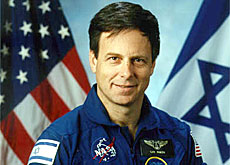World expresses sorrow over shuttle Columbia

World leaders have expressed shock and sadness after the space shuttle Columbia broke up as it re-entered the Earth's atmosphere, killing all seven crew members.
The space shuttle disintegrated just 15 minutes before it was due to land in Florida.
President George W Bush has received condolences from leaders across the globe.
The Swiss President, Pascal Couchepin, sent his sympathies to Bush on Saturday.
“On behalf of the Swiss government and the citizens of Switzerland, I would like to offer you, the American people and the victim’s family members, our deepest condolences,” Couchepin said.
The United States space agency, Nasa, said it lost contact with the shuttle as it flew over Texas at an altitude of 60 kilometres.
None of the seven crew members – which included the first Israeli in space – survived.
A grieving nation
Bush said the entire nation grieved with the families of the killed astronauts.
“The Columbia is lost. There are no survivors,” he said in an address to the nation. Bush also vowed the space program would continue.
“The cause in which they died will continue,” he said. “Our journey into space will go on.”
TV images beamed around the world showed the 22-year-old shuttle breaking up in a series of vapour trails, while eyewitnesses reported a long and loud sonic boom.
Nasa says it had no indications of any problems before it lost contact with the craft at around 3pm Saturday (Central European time).
Cause unknown
Nasa said it has launched an investigation to find out what destroyed the space shuttle.
Investigators are focusing on the possibility that Columbia’s thermal tiles were damaged more seriously than Nasa realised by a piece of debris during liftoff.
A little over a minute into Columbia’s launch a piece of insulating foam peeled away from the external fuel tank and hit the shuttle’s left wing.
The wing, and the underside of the shuttle, was covered with tiles to protect it from the intense heat on re-entry into the atmosphere.
“An amazing amount of power is needed when a shuttle re-enters the Earth’s atmosphere,” said Hanspeter Schneiter, a Swiss advisor to the European Space Agency.
“When it slows down to re-enter it is exposed to temperatures of up to 2,000 degrees Celsius,” Schneiter said in the “NZZ am Sonntag” newspaper.
“I assume that a part of the heat protection failed for some reason,” he said.
Swiss astronaut, Claude Nicollier, reacts
“It is a tragedy,” said Claude Nicollier, the first Swiss astronaut in space.
Nicollier, who has made four space shuttle trips – including one on the Columbia – expressed his sorrow about the tragedy.
“Everyone knows each other at Nasa – we’re a big family. I knew the crew aboard the Columbia – that’s why this is very difficult for me to talk about this. ” Nicollier said in the “SonntagsBlick” newspaper.
Disaster “touches all”
Patrick Piffaretti, head of the Swiss Space Office, described the shuttle disaster as a catastrophe that would affect people involved in space research around the world.
Piffaretti told swissinfo that the SSO offered its condolences to the families of the astronauts.
Daniel Neuenschwander, also from the SSO, said the disaster was a setback for the International Space Station – a project involving the Swiss via the European Space Agency.
He said the Nasa shuttle programme – which is likely to be grounded for a considerable time – was closely linked to the space station.
Swiss experiments on board
At least two bio-medical experiments linked to the Federal Institute of Technology in Zurich were carried on board the Columbia – among some 80 experiments on the ill-fated mission.
The Swiss-based research included tests on chemical changes involved in the human immune system.
The Columbia mission was billed as an opportunity to confirm earlier work involving human bone marrow stem cells.
A second Swiss experiment – conducted in cooperation with the Neuchatel-based firm Sevonic and the Nyon-based Mecanex group – involved testing highly sensitive measuring equipment.
The Challenger
Saturday’s disaster comes almost 17 years to the day after the space shuttle Challenger exploded after take-off.
As in 1986, the latest disaster is likely to severely restrict the shuttle programme until the cause has been identified.
It took almost three years for the shuttle programme to relaunch after the Challenger accident.
swissinfo with agencies
Space shuttle Columbia breaks up upon re-entry into the Earth’s atmosphere.
All seven astronauts on board, including the first Israeli in space, are killed.
World leaders express their condolences.
The Swiss astronaut, Claude Nicollier, who travelled aboard the Columbia and knew the crew, expresses sorrow.
Nasa launches investigation to find out what destroyed the space shuttle.
Investigators focus on possibility that thermal tiles – which protect the shuttle from the heat of re-entry – were damaged during liftoff.
Swiss Space Office warns of setbacks to the International Space Station project.
Crew:
Commander Rick Husband, 45
William McCool, 41
Michael Anderson, 43
Kalpana Chawla, 41, Indian-born astronaut
David Brown, 46
Laurel Clark, 41
Ilan Ramon, 48, first Israeli in space

In compliance with the JTI standards
More: SWI swissinfo.ch certified by the Journalism Trust Initiative











You can find an overview of ongoing debates with our journalists here . Please join us!
If you want to start a conversation about a topic raised in this article or want to report factual errors, email us at english@swissinfo.ch.